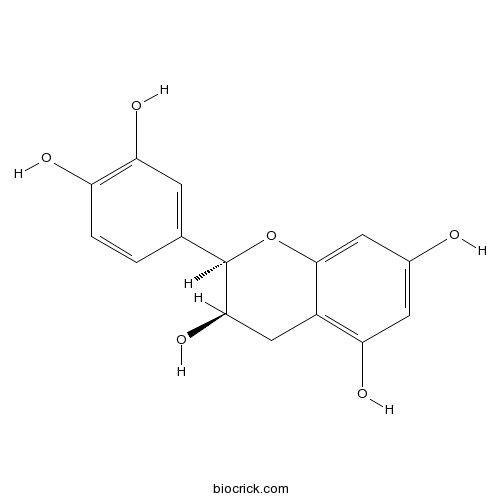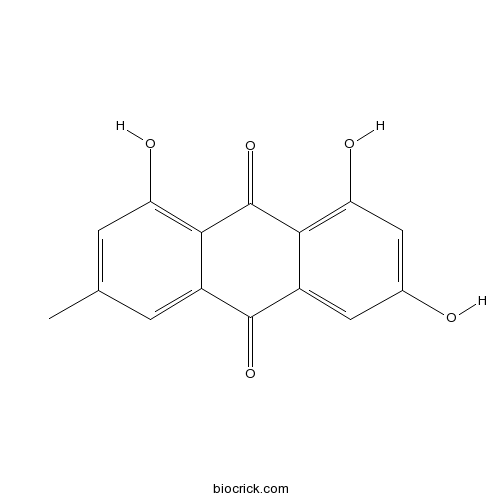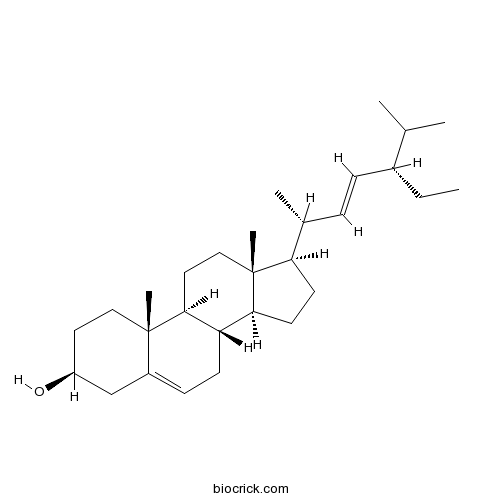Lilium davidii
Lilium davidii
1. The products in our compound library are selected from thousands of unique natural products; 2. It has the characteristics of diverse structure, diverse sources and wide coverage of activities; 3. Provide information on the activity of products from major journals, patents and research reports around the world, providing theoretical direction and research basis for further research and screening; 4. Free combination according to the type, source, target and disease of natural product; 5. The compound powder is placed in a covered tube and then discharged into a 10 x 10 cryostat; 6. Transport in ice pack or dry ice pack. Please store it at -20 °C as soon as possible after receiving the product, and use it as soon as possible after opening.
Natural products/compounds from Lilium davidii
- Cat.No. Product Name CAS Number COA
-
BCN5597
Epicatechin490-46-0
Instructions

-
BCN5649
Emodin518-82-1
Instructions

-
BCN4376
Stigmasterol83-48-7
Instructions

Effects of lily/maize intercropping on rhizosphere microbial community and yield of Lilium davidii var. unicolor.[Pubmed: 30101457]
Continuous cropping of lily (Lilium davidii var. unicolor) or any other crop seriously affects yield and quality. In this study, we compared continuous cropping with lily/maize intercropping. We also examined the lily rhizosphere microbes community in both sole lily cropping and lily/maize intercropping systems, by the llumina Miseq platform. Here we refer to data of recent years field experimentation of a lily/maize intercrop system in different planting configurations in the Gaolan Ecological and Agricultural Research Station. Treatments included sole crops of lily and maize, an intercrop consisting of strips of four lily rows alternating with one maize rows. The land equivalent ratio (LER) of intercrops was 1.294. The results showed that compared to sole cropping, the yield of lily in the first year of planting increased when lily was intercropped with maize. The species annotation of the high-throughput sequencing experiment showed that there was no difference in the diversity of the lily rhizosphere soil microbes on phylum taxonomic level, but the relative abundance of some genus changed obviously. The relative abundance of harmful fungus Fusarium spp. and, Funneliformis spp., decreased, and the relative abundance of beneficial bacteria Sphingomonas spp. and, Nitrospira spp., increased. In addition, we found that Lecanicillium spp., appeared only in the intercropping lily rhizosphere soil and sole cropping maize rhizosphere soil. In conclusion, the findings indicated that lily/maize intercropping could change soil microenvironment, and affect the diversity and structure of microorganism community in lily rhizosphere, with further beneficial effect on the yield of lily.
Illumina-based analysis of the rhizosphere microbial communities associated with healthy and wilted Lanzhou lily (Lilium davidii var. unicolor) plants grown in the field.[Pubmed: 27116961]
Lanzhou lily (Liliumdavidii var. unicolor) is the best edible lily as well as a traditional medicinal plant in China. The microbes associated with plant roots play crucial roles in plant growth and health. However, little is known about the differences of rhizosphere microbes between healthy and wilted Lanzhou lily (Lilium davidii var. unicolor) plants. The objective of this study was to compare the rhizosphere microbial community and functional diversity of healthy and wilted plants, and to identify potential biocontrol agents with significant effect. Paired end Illumina Mi-Seq sequencing of 16S rRNA and ITS gene amplicons was employed to study the bacterial and fungal communities in the rhizosphere soil of Lanzhou lily plants. BIOLOG technology was adopted to investigate the microbial functional diversity. Our results indicated that there were major differences in the rhizosphere microbial composition and functional diversity of wilted samples compared with healthy samples. Healthy Lanzhou lily plants exhibited lower rhizosphere-associated bacterial diversity than diseased plants, whereas fungi exhibited the opposite trend. The dominant phyla in both the healthy and wilted samples were Proteobacteria and Ascomycota, i.e., 34.45 and 64.01 %, respectively. The microbial functional diversity was suppressed in wilted soil samples. Besides Fusarium, the higher relative abundances of Rhizoctonia, Verticillium, Penicillium, and Ilyonectria (Neonectria) in the wilted samples suggest they may pathogenetic root rot fungi. The high relative abundances of Bacillus in Firmicutes in healthy samples may have significant roles as biological control agents against soilborne pathogens. This is the first study to find evidence of major differences between the microbial communities in the rhizospheric soil of healthy and wilted Lanzhou lily, which may be linked to the health status of plants.
Proteomic analysis reveals the differential histone programs between male germline cells and vegetative cells in Lilium davidii.[Pubmed: 26846354]
In flowering plants, male germline fate is determined after asymmetric division of the haploid microspore. Daughter cells have distinct fates: the generative cell (GC) undergoes further mitosis to generate sperm cells (SCs), and the vegetative cell (VC) terminally differentiates. However, our understanding of the mechanisms underlying germline development remains limited. Histone variants and modifications define chromatin states, and contribute to establishing and maintaining cell identities by affecting gene expression. Here, we constructed a lily protein database, then extracted and detailed histone entries into a comprehensive lily histone database. We isolated large amounts of nuclei from VCs, GCs and SCs from lily, and profiled histone variants of all five histone families in all three cell types using proteomics approaches. We revealed 92 identities representing 32 histone variants: six for H1, 11 for H2A, eight for H2B, five for H3 and two for H4. Nine variants, including five H1, two H2B, one H3 and one H4 variant, specifically accumulated in GCs and SCs. We also detected H3 modification patterns in the three cell types. GCs and SCs had almost identical histone profiles and similar H3 modification patterns, which were significantly different from those of VCs. Our study also revealed the presence of multiple isoforms, and differential expression patterns between isoforms of a variant. The results suggest that differential histone programs between the germline and companion VCs may be established following the asymmetric division, and are important for identity establishment and differentiation of the male germline as well as the VC.
Validation of Reference Genes for Accurate Normalization of Gene Expression in Lilium davidii var. unicolor for Real Time Quantitative PCR.[Pubmed: 26509446]
Lilium is an important commercial market flower bulb. qRT-PCR is an extremely important technique to track gene expression levels. The requirement of suitable reference genes for normalization has become increasingly significant and exigent. The expression of internal control genes in living organisms varies considerably under different experimental conditions. For economically important Lilium, only a limited number of reference genes applied in qRT-PCR have been reported to date. In this study, the expression stability of 12 candidate genes including α-TUB, β-TUB, ACT, eIF, GAPDH, UBQ, UBC, 18S, 60S, AP4, FP, and RH2, in a diverse set of 29 samples representing different developmental processes, three stress treatments (cold, heat, and salt) and different organs, has been evaluated. For different organs, the combination of ACT, GAPDH, and UBQ is appropriate whereas ACT together with AP4, or ACT along with GAPDH is suitable for normalization of leaves and scales at different developmental stages, respectively. In leaves, scales and roots under stress treatments, FP, ACT and AP4, respectively showed the most stable expression. This study provides a guide for the selection of a reference gene under different experimental conditions, and will benefit future research on more accurate gene expression studies in a wide variety of Lilium genotypes.
In vitro study of the growth, development and pathogenicity responses of Fusarium oxysporum to phthalic acid, an autotoxin from Lanzhou lily.[Pubmed: 25994089]
Continuous monoculture of Lanzhou lily (Lilium davidii var. unicolor Cotton) results in frequent incidence of fusarium wilt caused by Fusarium oxysporum. Phthalic acid (PA), a principal autotoxin from root exudates of Lanzhou lily, is involved in soil sickness by inducing autotoxicity. The aim of this study was to evaluate the direct allelopathic effects of PA on the growth, development and pathogenicity of F. oxysporum in vitro based on an ecologically relevant soil concentration. The results showed that PA slightly but not significantly inhibited the colony growth (mycelial growth) and fungal biomass of F. oxysporum at low concentrations ranging from 0.05 to 0.5 mM, and significantly inhibited the colony growth at the highest concentration (1 mM). None of the PA concentrations tested significantly inhibited the conidial germination and sporulation of F. oxysporum in liquid medium. However, mycotoxin (fusaric acid) yield and pathogenesis-related hydrolytic enzyme (protease, pectinase, cellulase, and amylase) activities were significantly stimulated in liquid cultures of F. oxysporum containing PA at ≥ 0.25 mM. We conclude that PA at a soil level (i.e. 0.25 mM) is involved in plant-pathogen allelopathy as a stimulator of mycotoxin production and hydrolytic enzyme activities in F. oxysporum, which is possibly one of the mechanisms responsible for promoting the wilt disease of lily.
Transcriptome analysis of carbohydrate metabolism during bulblet formation and development in Lilium davidii var. unicolor.[Pubmed: 25524032]
The formation and development of bulblets are crucial to the Lilium genus since these processes are closely related to carbohydrate metabolism, especially to starch and sucrose metabolism. However, little is known about the transcriptional regulation of both processes. To gain insight into carbohydrate-related genes involved in bulblet formation and development, we conducted comparative transcriptome profiling of Lilium davidii var. unicolor bulblets at 0 d, 15 d (bulblets emerged) and 35 d (bulblets formed a basic shape with three or four scales) after scale propagation.
[Phylogenetic analysis for Fritillaria hupehensis: evidence from ITS, rpl16 and matK sequences].[Pubmed: 25522609]
The systematic position of Fritillaria hupehensis has been in dispute. Phylogentic analyses were conducted on sequences of ITS, rpl16, matK sequences for species of F. hupehensis and allies. Lilium davidii was designed as outgroup. The analyses were performed using MP and ML methods. Conclusions could be achieved as follow. The topologies of MP and ML are consistent. The samples of F. hepehensis from different places form a supported clade with a strong bootstrap. And then form a strongly supported clade with F. anhuiensis, F. monantha. The results suggests that although F. hupehensis has a closet relation with the two ones, it exists some difference.
Overexpression of small heat shock protein LimHSP16.45 in Arabidopsis enhances tolerance to abiotic stresses.[Pubmed: 24349240]
Small heat shock proteins (smHSPs) play important and extensive roles in plant defenses against abiotic stresses. We cloned a gene for a smHSP from the David Lily (Lilium davidii (E. H. Wilson) Raffill var. Willmottiae), which we named LimHSP16.45 based on its protein molecular weight. Its expression was induced by many kinds of abiotic stresses in both the lily and transgenic plants of Arabidopsis. Heterologous expression enhanced cell viability of the latter under high temperatures, high salt, and oxidative stress, and heat shock granules (HSGs) formed under heat or salinity treatment. Assays of enzymes showed that LimHSP16.45 overexpression was related to greater activity by superoxide dismutase and catalase in transgenic lines. Therefore, we conclude that heterologous expression can protect plants against abiotic stresses by preventing irreversible protein aggregation, and by scavenging cellular reactive oxygen species.


